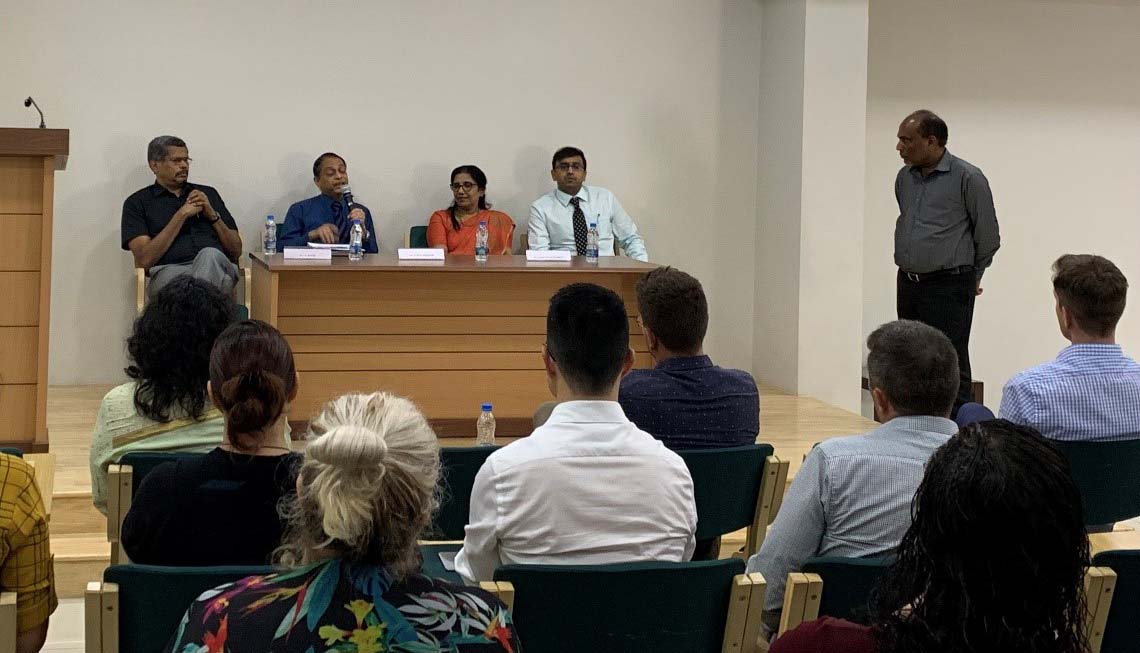IT in India
Day three saw the group visit Rajagiri Business School to hear from business leaders and academics about the IT industry in India.

Arriving at the beautiful Rajagiri campus, we were welcomed with a refreshing coconut to drink, some massive cashew nuts, and banana chips, continuing the growing theme of food being laid out everywhere we went.
Each speaker offered an insightful glimpse into the IT industry in India. It was a delightful surprise to be welcomed in te reo māori. Briefly touching on the various medical fields in India was a lesson in how different cultures view health and wellness. We heard about the Indian start up ecosystem and the scaling of start-ups including the critical bottleneck of fund sourcing. It was also interesting to be taken through a history of the Indian IT industry from Y2K to service and now the v3.0 digital transition. From all accounts, the Indian economy continues to charge ahead with an incredible 7.3% GDP growth in 2018.
New technologies changing business in India, as with elsewhere, include; AI, advanced analytics, blockchain, cybersecurity, IoT, along with AR/VR and mixed reality.
A challenge that was highlighted in one of the presentations was that getting people with the requisite math’s skills was difficult so if you fancy yourself with numbers you could land yourself a lucrative role on the sub-continent.
 The group was inspired by the speaker whose journey started in 1988 to become the first woman in India to manufacture transformers. After 18 years she left that company and started another from scratch. Women make up only 27% of those in the professional field in India and she is passionate about getting more involved in entrepreneurship.
The group was inspired by the speaker whose journey started in 1988 to become the first woman in India to manufacture transformers. After 18 years she left that company and started another from scratch. Women make up only 27% of those in the professional field in India and she is passionate about getting more involved in entrepreneurship.
We later heard about the Nest Group of companies, a quite incredible growth story which was started by two brothers in 1991 as an outsource partner for US companies which now has 7,000 employees and offices worldwide. The company started out as contract electronic manufacturers in Cochin India for several multinational companies and has branched into the design and manufacturing of a wide range of related products.
The presentations were packed with interesting information and highlighted the obvious potential for growth in India. We then enjoyed a lovely lunch provided by Rajagiri - the food on the trip so far has been a great experience, vastly different to anything from back home.
After saying farewell to the Rajagiri Business School, we made our way to Tata Consultancy Services (TCS). This was an experience in truly big business, with over 300,000 staff. It is safe to say that Tata is huge beyond our understanding and is much like India itself; vast and diverse. We were told as a part of the presentation opening that not a single Indian resident has not used a Tata product at some time.
We heard about Tata's view of the various waves of the industrial revolution and the coming fourth wave of full automation. Tata 4.0 is getting businesses ready for their own Industry Version 4.0 challenges.
We were full of admiration, to hear that the Tata India business model includes a significant corporate social responsibility component; for every $1 returned to shareholders, 47c goes back to the community. On the face of it, a compelling point of difference.
The day closed with us leaving Kochi on the long bus ride to the beautiful IIM Kozhikode campus. This was, like everything we have done so far on the trip, unlike anything we have experienced before. The typical Kiwi experience of being on a bus between towns is a view of vast farms and green fields. On this journey, it was hard to tell where one town ended and the other began.
